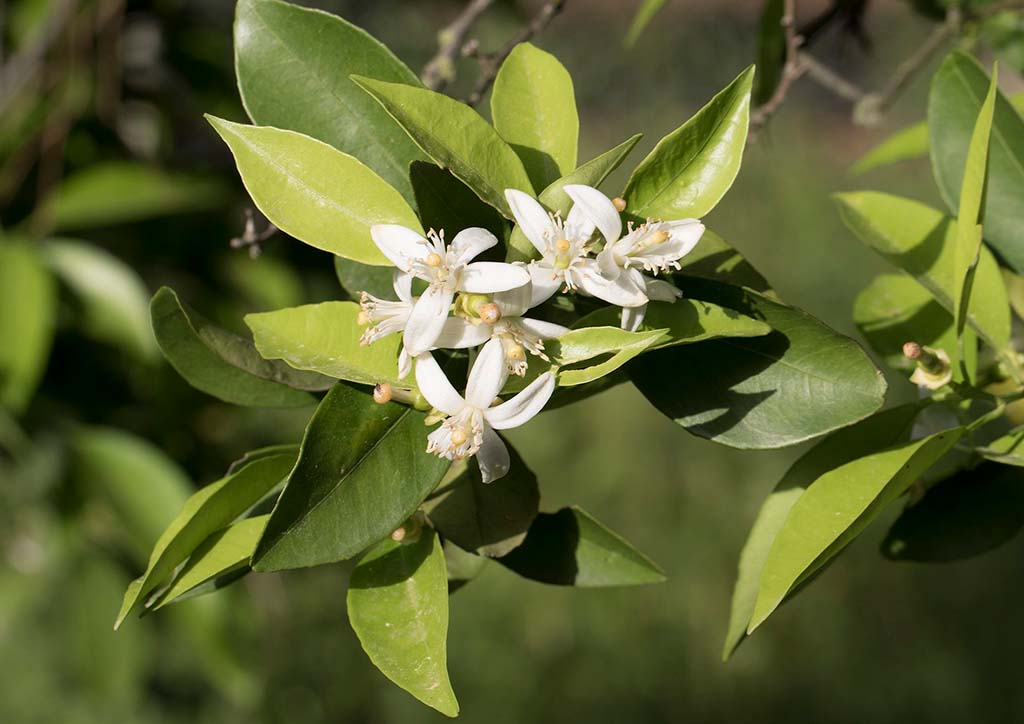
Libya
Orange Blossom
Citrus sinensis

General Description / Cultural Significance
Libya is a North African country that looks over the Mediterranean Sea. Much of its population is now concentrated on the coast as the interior of the country is covered with the vast desert and semidesert of the Saharan plateau. Libyans did not always live on the coast, though. The Tuareg people, decedents of the tribal Berbers, are known to have spread the traditions of Islam, and have inhabited the desert for more than a thousand years. DNA studies have shown that most of the population now living in cities comes from these tribes that once lived nomadic lifestyles.
Across Libya’s sand dunes, salt marshes, plains, and coastal limestone mountains, the smell of Orange Blossom, Citrus sinensis, permeates the air. The plant was introduced to the country and is now well established, a part of Libyan flora. It is primarily cultivated in orchards throughout the country. Orange Blossom water is an aromatic substance made through the distillation of bitter Orange Blossoms for their essential oil. The distillation ritual is depicted in abundance throughout Libyan literature, poetry, and art. Rich portrayals can be found describing the plant’s dizzying scent filling the air where flower petals are gathered and distilled for perfume and other products out on the patios of Libyan homes. Libyan women often fragrance themselves with the scent of Orange Blossom. From their city balconies, the Libyan people have a tradition of sprinkling Orange Blossom water over people during parades.
Orange Blossom water is used in many culinary traditions, desserts, and meals. One such significant recipe is Khoshaf, a fruit salad sprinkled with Orange Blossom water that is served in small portions break the fast before the sunset prayers of Ramadan. Orange Blossom flavors sweets for the Eid holiday and is even added for its aroma to Libyan’s daily coffee. This scent memory is widely remembered and enjoyed by Libyans across time.
Climate Change / Conservation Status
Libya is rich in oil and incredibly scarce of water. Some areas of the country’s desert don’t see rainfall for years straight, which researchers predict to only worsen as climate change continues to impact the region. Even the Mediterranean coastal region of Libya is experiencing increased drought, decline in fish stocks, and ocean acidification. Water access is such a concern for Libyans that The Great Manmade River Project, called the world’s largest irrigation project, began development in the early 1960s. Non-renewable fossil water from the last ice age is pumped all the way from the Nubian Sandstone aquifers under the Sahara to the coastal cities of Libya. This aquifer supplies eighty percent of the country’s water, but is not being replenished, making it an unsustainable, temporary solution to Libya’s water problem.
More and more farmers are leaving their land and moving to cities as their crop yields no longer produce a reliable income. Across the Middle East, desertification is predicted to cause significant damage to the production of Citrus sinensis exports while increasing plant diseases and pests that harm the Orange Blossom trees. Furthermore, climate change induced temperature increases and extreme weather events have been destroying honeybee hives in Libya. Not only is the generational tradition of beekeeping suffering, but the decimation of honeybee populations has greatly affected the success of Citrus species which depend on honeybees for pollination. Combined with Citrus sinensis’ sensitivity to the country’s daily water stress, the Orange Tree will be in a perilous position if sustainable irrigation methods are not implemented and the bee population is not stabilized.
Alternate Names
Queen Orange
Sources
Sugar, Spice and Life, 2017. An Eid Tradition – Libyan Magrood (Semolina, Date & Honey Cookies). WordPress. [website]
Climate Links, 2022. Climate Risk Profile: Libya. US AID. [website]
Libyan Food, 2011. Dried fruit salad: Khoshaf. Blogger. [website]
Aulakh, R., 2013. Climate change significant challenge facing Libya. The Star. [website]
Barbour, N., et. al., 2022. Libya. Encyclopedia Britannica. [website]
Ciantar, P., 2016. The ma’lūf in contemporary Libya: An Arab Andalusian musical tradition, Abingdon: Routledge. [website]
Elmusrati, S., 2011. A Likely Story. We Are Food. [website]
Fallaha, A., 2021. In pictures: War, climate change and cheap imports squeeze citrus crop in Syria’s Idlib. Middle East Eye. [website]
Keshlaf, M., 2014. Beekeeping in Libya. International Journal of Agricultural and Biosystems Engineering, 8(1).
Office of the Ambassador, Mission of the Socialist People’s Libyan Arab Jamahiriya to the United Nations. This statement can be found on the World Sensorium original website.
Roumani, J., Meghnagi, D., & Roumani, J., 2018. Jewish Libya: Memory and Identity in Text and Image, Syracuse University Press.
Shafieizargar, A., et al., 2012. Yield and fruit quality of ‘Queen’ orange [Citrus sinensis (L) Osb.] grafted on different rootstocks in Iran. Australian Journal of Crop Science, 6(5), pp.777–783.
Shafqat, W., et al., 2021, ‘Climate Change and Citrus’, in M. S. Khan, I. A. Khan (eds.), Citrus – Research, Development and Biotechnology, IntechOpen, London. DOI: 10.5772/intechopen.95488.

